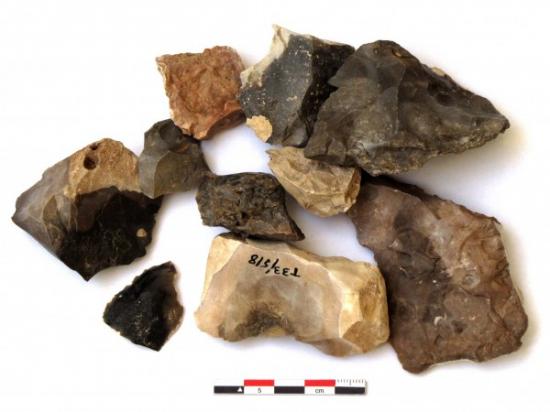Nala Rogers
Source - http://news.sciencemag.org/archaeology/2014/12/israeli-cave-offers-clues-about-when-humans-mastered-fire

Flint artifacts show rounded pits where “pot lids” flaked off in the heat of a prehistoric fire. RON SHIMELMITZ
Mastering fire was one of the most important developments in human prehistory. But it’s also one of the hardest to pin down, with different lines of evidence pointing to different timelines. A new study of artifacts from a cave in Israel suggests that our ancestors began regularly using fire about 350,000 years ago—far enough back to have shaped our culture and behavior but too recent to explain our big brains or our expansion into cold climates.
If most archaeological sites offer a snapshot of the ancient past, Tabun Cave provides a time-lapse video. The site, about 24 kilometers south of Haifa, documents 500,000 years of human history. “Tabun Cave is unique in that it’s a site with a very long sequence,” says Ron Shimelmitz, an archaeologist at the University of Haifa and a co-author on the new study. “We could examine step by step how the use of fire changed in the cave.”
The researchers examined artifacts previously excavated from the site, which are mostly flint tools for cutting and scraping, and flint debris created in their manufacture. To determine when fire became a routine part of the lives of the cave dwellers, the team looked at flints from about 100 layers of sediments in the lowermost 16 meters of the cave deposits.
In layers older than roughly 350,000 years, almost none of the flints are burned. But in every layer after that, many flints show signs of exposure to fire: red or black coloration, cracking, and small round depressions where fragments known as pot lids flaked off from the stone. Wildfires are rare in caves, so the fires that burned the Tabun flints were probably controlled by ancestral humans, according to the authors. The scientists argue that the jump in the frequency of burnt flints represents the time when ancestral humans learned to control fire, either by kindling it or by keeping it burning between natural wildfires.
The findings are consistent with data from several nearby sites. On their own, these other sites provide little information about when humans mastered fire, because they represent shorter slices of time and most are not well dated. But in combination with the long, detailed record from Tabun, they suggest that ancestral humans all over the eastern Mediterranean learned to control fire around the same time, Shimelmitz says. Earlier ancestral humans may have used fire occasionally when they could find it, but because their artifacts show few signs of burning, they probably didn’t use it daily, the researchers report in this month’s issue of the Journal of Human Evolution.
This time frame is consistent with that of European sites. A 2011 review dated routine fire use in Europe to between 400,000 and 300,000 years ago. Together with the new study from Tabun, the data suggest that ancient humans did not master fire until hundreds of thousands of years after they expanded into cold climates. There are earlier sites with evidence of fire, but these are rare and often hard to interpret, according to Paola Villa of the University of Colorado Museum of Natural History in Boulder, a co-author of the 2011 review.
The new study won't end the debate, however. A few researchers have argued that ancestral humans did not regularly control fire until more recently, and others, such as Richard Wrangham of Harvard University, think that our ancestors mastered fire much earlier. Wrangham has argued that our ancestors started cooking food about 2 million years ago, when humans evolved smaller teeth and guts. He credits fire for favoring the evolution of many human traits, including our large brains.
All of those changes began long before the rise of burnt flints in Tabun Cave. Although he calls the finds “exciting,” Wrangham is not convinced by the sequence at this single site. The earliest inhabitants may have used the cave in different ways, such as to gather materials or butcher animals, saving their cooking for open-air sites, he says. “We clearly need more information.”
But he and Shimelmitz agree that whenever it arrived, fire gave ancestral humans tremendous advantages, including cooking, warmth, light in the night, and safety from predators. "There's a reason people think we got fire from the gods,” Shimelmitz adds.